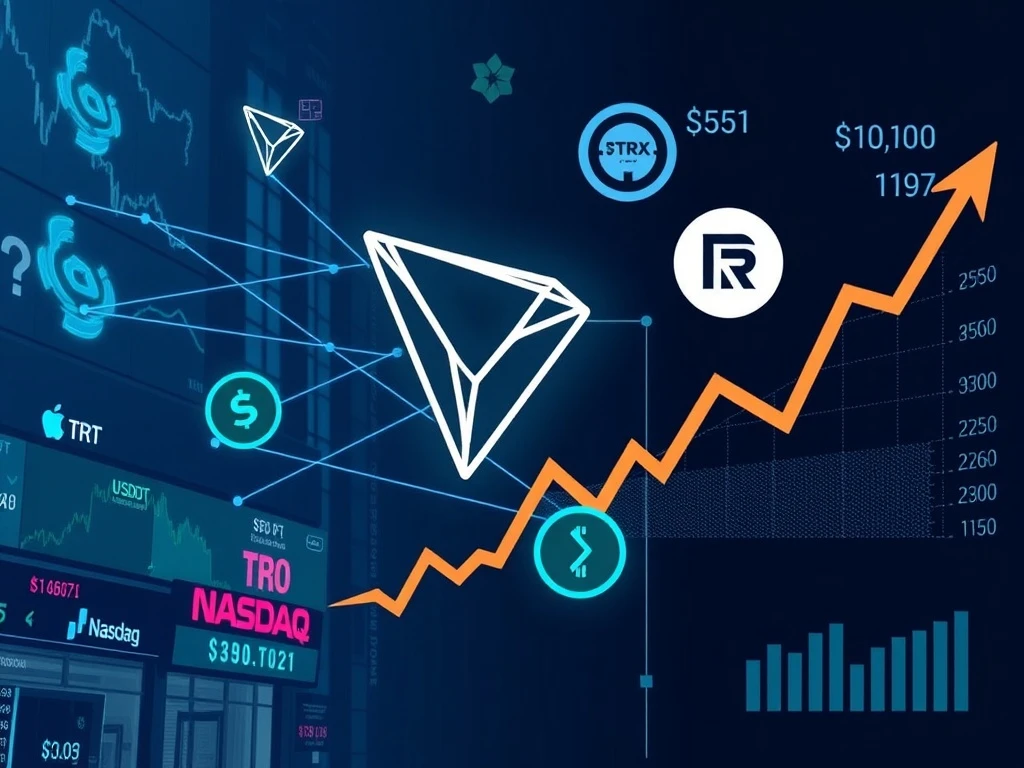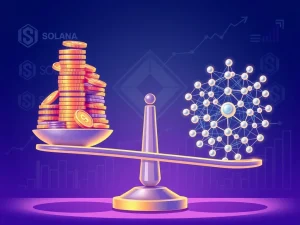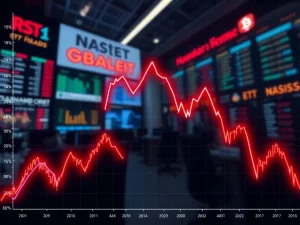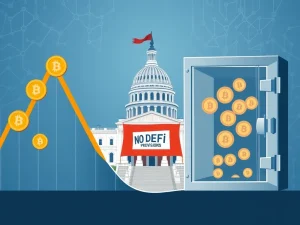Tron Nasdaq Listing: The Crucial Paradox of Surging On-Chain Growth vs. Stock Decline

The recent Tron Nasdaq Listing has ignited a fascinating debate within the crypto community. How can a network that boasts record-breaking on-chain activity see its public market debut met with a stock decline? This article dives into the intricate dynamics behind Tron’s market performance, exploring the surprising divergence between its robust blockchain fundamentals and its initial stock market reception.
Decoding the Tron Nasdaq Listing Paradox
Tron’s foray into the Nasdaq, facilitated by a reverse merger with SRM Entertainment, marked a significant milestone. Founder Justin Sun’s ringing of the opening bell on July 24, 2025, symbolized Tron’s ambition to bridge the gap between decentralized technology and traditional finance. However, the immediate aftermath presented a paradox: despite this symbolic achievement, the stock price saw a decline.
This hybrid approach, blending Tron’s blockchain infrastructure with SRM’s consumer product business, has raised questions. Analysts express skepticism about the integration of Tron’s digital asset operations with SRM’s traditional ventures. This structural complexity could potentially complicate governance and dilute focus for shareholders, impacting the initial investor sentiment around the Tron Nasdaq Listing.
Understanding TRX Price Performance Post-Debut
While the broader market observed the stock’s decline, the TRX Price Performance tells a more nuanced story. Although the immediate impact on TRX’s price was muted, the token has shown a gradual upward trend post-listing. This suggests a disconnect between the traditional stock market’s reaction to the merger and the underlying utility and demand for the native TRX token.
A key observation is the dip in Total Value Locked (TVL) on the Tron platform, which decreased from $5.847 billion to $5.711 billion in the weeks leading up to the Nasdaq debut. This decline in TVL, even as on-chain activity surged, indicates a divergence between transactional utility and immediate investor sentiment surrounding the public listing. However, analysts point to factors like Tron’s shrinking token supply, driven by buybacks, as potential long-term value drivers for TRX Price Performance.
Unpacking Tron On-Chain Metrics: A Deep Dive into Activity
Beyond the stock market headlines, Tron On-Chain Metrics paint a picture of impressive growth and adoption. The network has achieved significant milestones, including:
- Stablecoin Supply: Tron now hosts over $80 billion in USDT, surpassing Ethereum in stablecoin supply.
- Transaction Volume: The network processes an astonishing 14 billion transactions, reflecting its high throughput capabilities.
- Cumulative Fees: Total fees collected on the network have exceeded $2 billion, demonstrating robust economic activity.
- Daily Activity: Daily transactions average 8–9 million, nearly doubling the pace observed during the last bear market.
These figures underscore Tron’s expanding role in decentralized finance, particularly as a preferred network for low-cost, high-speed stablecoin transfers. The surge in these Tron On-Chain Metrics directly bolsters demand for TRX, as network fees are primarily paid in the native token.
What Drives TRON Network Growth?
The consistent climb in cumulative fees and transaction volumes throughout 2024 and 2025 highlights sustained TRON Network Growth. A significant driver is its appeal for stablecoin transfers. Over $22 billion in USDT has been minted on Tron in 2025 alone, reflecting its efficiency and cost-effectiveness compared to other networks.
The architecture of the Tron network, designed for high scalability and low transaction costs, makes it an attractive choice for users seeking quick and affordable transfers, especially for stablecoins. This utility directly contributes to the demand for TRX, as it is the primary token used for network fees. The continuous accumulation of fees and transactions serves as a strong indicator of organic TRON Network Growth and utility, forming a robust foundation for its ecosystem.
USDT Dominance and Tron’s Strategic Position
Tron’s strategic focus on stablecoins, particularly its dominance in hosting USDT, positions it uniquely in the crypto landscape. The network’s ability to facilitate a vast amount of stablecoin transfers has made it a backbone for global digital payments. This USDT Dominance is a significant competitive advantage, attracting both retail and institutional users seeking reliable and inexpensive ways to move value.
Furthermore, Tron’s expansion to host cross-chain tokens like $TRUMP demonstrates its flexibility and adaptability. While this diversification broadens its ecosystem, the core challenge remains converting this on-chain activity and USDT Dominance into sustained investor demand and a clearer public market valuation model, especially given the complexities of its hybrid listing structure.
Conclusion: Navigating the Nuances of Tron’s Journey
Tron’s Nasdaq listing represents a bold step towards mainstream adoption, yet its initial market reception underscores the complexities of valuing a hybrid blockchain-traditional business entity. While the stock’s immediate decline presented a stark contrast, the underlying Tron On-Chain Metrics—surging fees, transactions, and USDT Dominance—tell a compelling story of organic TRON Network Growth and utility. For TRX holders, the long-term outlook will hinge on sustained transaction volume growth, strategic institutional partnerships, and the network’s ability to maintain its lead in the stablecoin sector. The short-term volatility is likely to persist as investors reconcile the risks of the hybrid model with Tron’s undeniable operational scale and its impressive TRX Price Performance trajectory in the crypto market itself.
Frequently Asked Questions (FAQs)
Q1: Why did Tron’s stock decline after its Nasdaq listing, despite strong on-chain metrics?
Tron’s Nasdaq listing occurred via a reverse merger with SRM Entertainment, a traditional consumer product business. Analysts expressed skepticism about the integration of Tron’s blockchain operations with SRM’s traditional business, leading to concerns about governance, diluted focus, and a lack of a clear revenue model from SRM’s side. This structural complexity likely contributed to the initial stock decline, overshadowing the robust on-chain growth.
Q2: How does Tron’s on-chain activity compare to other major blockchains like Ethereum?
Tron has significantly outpaced Ethereum in several key on-chain metrics. It hosts over $80 billion in USDT, surpassing Ethereum in stablecoin supply. Additionally, Tron processes 14 billion transactions and averages 8-9 million daily transactions, nearly double Ethereum’s pace during the last bear market. Its cumulative fees have also exceeded $2 billion, demonstrating high network utilization.
Q3: What role does USDT play in Tron’s ecosystem and growth?
USDT (Tether) plays a crucial role in Tron’s ecosystem. Tron has become a preferred network for low-cost, high-speed stablecoin transfers, with over $22 billion in USDT minted on the network in 2025 alone. This dominance in USDT transactions drives demand for the native TRX token, as network fees are primarily paid in TRX, directly contributing to TRON Network Growth and utility.
Q4: What are the key factors that could drive long-term value for TRX holders?
Several factors could drive long-term value for TRX holders. These include sustained transaction volume growth, particularly for stablecoins, strategic initiatives to attract institutional partnerships, and the network’s ability to maintain its lead in USDT activity. Additionally, Tron’s shrinking token supply, driven by buybacks, and its foundational role for USDT transactions are seen as positive indicators for long-term value.
Q5: Is Tron’s Nasdaq listing beneficial for the TRX token?
While the initial stock performance of the merged entity was mixed, the Nasdaq listing provides symbolic recognition and potential for broader institutional awareness for Tron. For the TRX token itself, its value is more directly tied to on-chain utility, transaction volume, and the network’s fundamental growth. The listing might indirectly benefit TRX by increasing visibility and potentially attracting more users and developers to the TRON Network, but the direct impact on TRX Price Performance is primarily driven by supply and demand dynamics within the crypto market.






